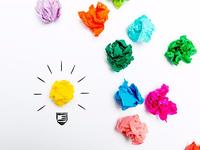Actual sales figures have not been divulged but deputy editor Graham Lawton said it was the second-highest selling of the year, “which is unheard of in August”.
As well as being up 12% year-on-year, Lawton said sales of the neuromarketing issue were “significantly higher” than the average figure for the year.
“We would certainly say the experiment was a big success,” said Lawton – but would he go as far as saying neuromarketing works based on this experiment? “No,” he said. “That would be unscientific.”
More studies would be needed to get anywhere near to reaching such a conclusion, and those experiments would certainly need to be more robust. For starters, it would be interesting to pit two covers – one neuro-tested, one not – against each other in the market to see which came out on top.
As it was in this experiment, only the most popular cover made it to print. Nineteen New Scientist readers were shown three potential covers during electroencephalographic (EEG) tests conducted by NeuroFocus that measured and analysed their responses.
The readers’ brainwave activity was monitored to see their immediate reaction to the designs in terms of attention, emotional engagement, memory retention, purchase intent, novelty and awareness and overall effectiveness.
It would also be useful to re-run the experiment without the accompanying PR fanfare. New Scientist’s tie-up with NeuroFocus was heavily publicised on the day the issue hit newsstands: as well as our own report, the story was also covered in mainstream titles like the New York Times and Fast Company.
Lawton conceded the possibility that all this press could have helped fuel sales. “There’s no real way of telling,” he said. “In the past we’ve seen coverage like this actually depress sales. We assume that once people have seen the story elsewhere they don’t feel the need to read it from the horses mouth.”
Overall, though, he feels the experiment has been a positive one for New Scientist. “We’ve learned some general lessons from this that we’re applying every week, and we hope that we’ll see a general upturn in sales as a result.
“I don’t see us doing any more neuromarketing studies,” says Lawton, “but we’re always open to ideas that can help us to produce better, more attractive and compelling covers.”
For its part, NeuroFocus CEO A. K. Pradeep says: “What these results for New Scientist add is clear, unmistakable and very public validation for the core science that underlies all that we do.”







3 Comments
Neil Gains
14 years ago
I am a great believer in neuroscience, but I don't believe that this stunt proves anything. The results could also be a "clear public validation" that publicity and word of mouth drive sales!
Like Reply Report
Jeffrey Henning
14 years ago
A 12% increase and they're not going to use neuromarketing again?! Sounds like they don't believe it was the neuromarketing either.
Like Reply Report
BQ
14 years ago
A few disjointed thoughts; Sounds like new-scientist are believer. More data will come, this approach to design I am sure will continue so lets see how future sales fare. It would have been useful if the follow-up steps were indicated or else one is left wonder if this is PR or Science. This is a new area, but any edge is valuable esp when they can be validated with sales data. I am going to by the Book on the neurofocus web site.Well I am not going to buy it, my brain is I am just going to pay for it. Pradeep's response is solid CEO material, so good luck! Having an inviting door is one thing. To keep people opening that door and coming into the house of pleasure, requires informative, useful and engaging content.
Like Reply Report